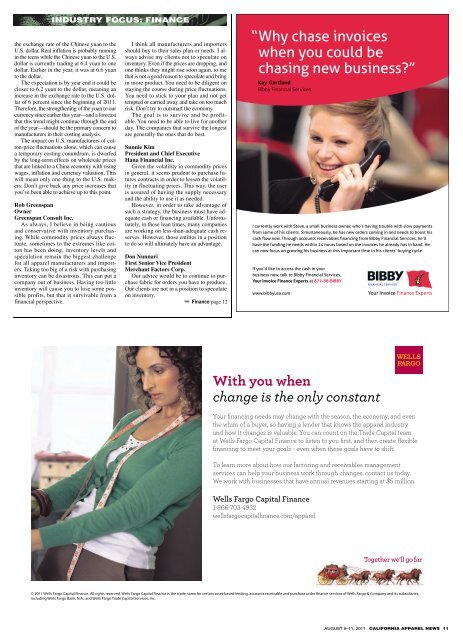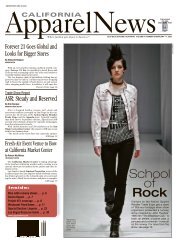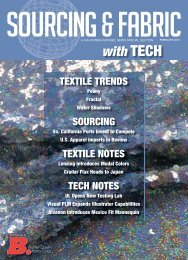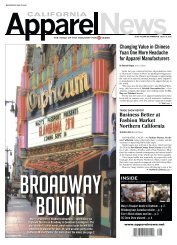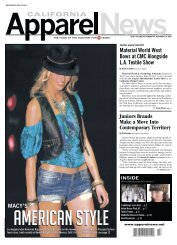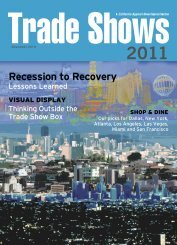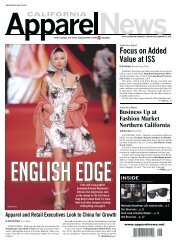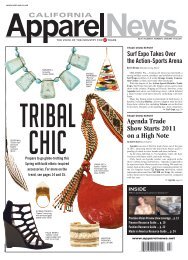here - California Apparel News
here - California Apparel News
here - California Apparel News
Create successful ePaper yourself
Turn your PDF publications into a flip-book with our unique Google optimized e-Paper software.
INduStRy FOCuS: FINANCE<br />
the exchange rate of the Chinese yuan to the<br />
U.S. dollar. Real inflation is probably running<br />
in the teens while the Chinese yuan to the U.S.<br />
dollar is currently trading at 6.4 yuan to one<br />
dollar. Earlier in the year, it was at 6.6 yuan<br />
to the dollar.<br />
The expectation is by year end it could be<br />
closer to 6.2 yuan to the dollar, meaning an<br />
increase in the exchange rate to the U.S. dollar<br />
of 6 percent since the beginning of 2011.<br />
T<strong>here</strong>fore, the strengthening of the yuan to our<br />
currency since earlier this year—and a forecast<br />
that this trend might continue through the end<br />
of the year—should be the primary concern to<br />
manufacturers in their costing analysis.<br />
The impact on U.S. manufacturers of cotton-price<br />
fluctuations alone, which can cause<br />
a temporary costing conundrum, is dwarfed<br />
by the long-term effects on wholesale prices<br />
that are linked to a China economy with rising<br />
wages, inflation and currency valuation. This<br />
will mean only one thing to the U.S. makers:<br />
Don’t give back any price increases that<br />
you’ve been able to achieve up to this point.<br />
Rob Greenspan<br />
Owner<br />
Greenspan Consult Inc.<br />
As always, I believe in being cautious<br />
and conservative with inventory purchasing.<br />
While commodity prices always fluctuate,<br />
sometimes to the extremes like cotton<br />
has been doing, inventory levels and<br />
speculation remain the biggest challenge<br />
for all apparel manufacturers and importers.<br />
Taking too big of a risk with purchasing<br />
inventory can be disastrous. This can put a<br />
company out of business. Having too little<br />
inventory will cause you to lose some possible<br />
profits, but that is survivable from a<br />
financial perspective.<br />
I think all manufacturers and importers<br />
should buy to their sales plan or needs. I always<br />
advise my clients not to speculate on<br />
inventory. Even if the prices are dropping, and<br />
one thinks they might rise soon again, to me<br />
that is not a good reason to speculate and bring<br />
in more product. You need to be diligent on<br />
staying the course during price fluctuations.<br />
You need to stick to your plan and not get<br />
tempted or carried away and take on too much<br />
risk. Don’t try to outsmart the economy.<br />
The goal is to survive and be profitable.<br />
You need to be able to live for another<br />
day. The companies that survive the longest<br />
are generally the ones that do best.<br />
Sunnie Kim<br />
President and Chief Executive<br />
Hana Financial Inc.<br />
Given the volatility in commodity prices<br />
in general, it seems prudent to purchase futures<br />
contracts in order to lessen the volatility<br />
in fluctuating prices. This way, the user<br />
is assured of having the supply necessary<br />
and the ability to use it as needed.<br />
However, in order to take advantage of<br />
such a strategy, the business must have adequate<br />
cash or financing available. Unfortunately,<br />
in these lean times, many companies<br />
are working on less-than-adequate cash reserves.<br />
However, those entities in a position<br />
to do so will ultimately have an advantage.<br />
Don Nunnari<br />
First Senior Vice President<br />
Merchant Factors Corp.<br />
Our advice would be to continue to purchase<br />
fabric for orders you have to produce.<br />
Our clients are not in a position to speculate<br />
on inventory.<br />
➥ Finance page 12<br />
With you when<br />
change is the only constant<br />
Your financing needs may change with the season, the economy, and even<br />
the whim of a buyer, so having a lender that knows the apparel industry<br />
and how it changes is valuable. You can count on the Trade Capital team<br />
at Wells Fargo Capital Finance to listen to you first, and then create flexible<br />
financing to meet your goals – even when those goals have to shift.<br />
To learn more about how our factoring and receivables management<br />
services can help your business work through changes, contact us today.<br />
We work with businesses that have annual revenues starting at $5 million.<br />
Wells Fargo Capital Finance<br />
1-866-703-4932<br />
wellsfargocapitalfinance.com/apparel<br />
© 2011 Wells Fargo Capital Finance. All rights reserved. Wells Fargo Capital Finance is the trade name for certain asset-based lending, accounts receivable and purchase order finance services of Wells Fargo & Company and its subsidiaries,<br />
including Wells Fargo Bank, N.A., and Wells Fargo Trade Capital Services, Inc.<br />
August 5–11, 2011 CALIFORNIA APPAREL NEWS 11


